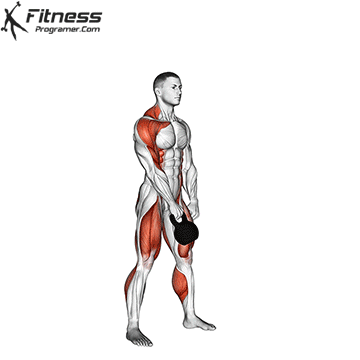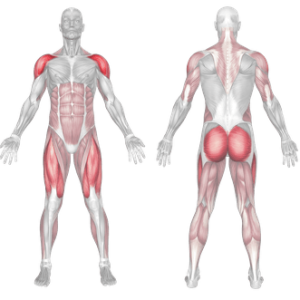The one-arm kettlebell snatch is a dynamic exercise that engages multiple muscle groups, particularly targeting the shoulders, back, hips, and core. It develops the entire posterior chain of the body while building strength, coordination, and cardiovascular fitness simultaneously.
How To One Arm Kettlebell Snatch

- Starting Position: Stand with your feet shoulder-width apart, knees slightly bent, and the kettlebell placed on the floor between your feet. Your hips should be hinged back slightly, and your back should be straight.
- Grip the Kettlebell: Reach down with one hand and grip the handle of the kettlebell firmly. Your palm should be facing your body.
- Initiate the Movement: In one fluid motion, drive through your hips and legs to generate power. As you do this, simultaneously pull the kettlebell up explosively, using the momentum to lift it towards your shoulder.
- Rotation: When the kettlebell reaches shoulder height, rotate your hand so that your palm is facing up.
- Lockout: Once the kettlebell reaches shoulder height, lock your arm out overhead by fully extending your elbow.
- Lower the Kettlebell: Reverse the motion by lowering the kettlebell back down to the starting position with control. Keep your core engaged and your back straight throughout the movement.
- Repeat: Perform the desired number of repetitions on one arm before switching to the other arm.
Tips:
- Keep the movement smooth and controlled, avoiding any jerky motions.
- Engage your core throughout the exercise to maintain stability and protect your lower back.
- Focus on using the power generated from your hips and legs to drive the movement, rather than relying solely on your arm strength.
- Start with a lighter kettlebell to master the technique before progressing to heavier weights.
- Pay attention to your breathing, exhaling as you lift the kettlebell and inhaling as you lower it.
Benefits
Full-body Workout: The snatch engages multiple muscle groups simultaneously, including the shoulders, back, hips, glutes, hamstrings, and core. This makes it a highly efficient exercise for building strength and muscle mass. In as little as 15-20 minutes, you can perform both a cardio and strength workout.
Explosive Power: The snatch involves a powerful hip drive and explosive movement to propel the kettlebell from the ground to overhead. This helps develop explosive power, which is beneficial for sports performance and functional movements in daily life.
Improved Cardiovascular Conditioning: Performing snatches at a moderate to high intensity can elevate your heart rate and provide a cardiovascular workout, contributing to improved cardiovascular health and endurance.
Calorie Burn and Fat Loss: Snatches are a high-intensity exercise that can help burn a significant number of calories in a relatively short amount of time. When combined with a balanced diet and regular exercise routine, snatches can contribute to fat loss and weight management.
Functional Strength: The snatch mimics the movement patterns of lifting and reaching, which are common in daily activities and sports. By strengthening these movement patterns, the snatch can improve functional strength and performance in various real-world scenarios.
Core Stability and Balance: Maintaining proper form throughout the snatch requires strong core stability and balance. Over time, practicing snatches can help strengthen the muscles that support your spine and improve overall balance and stability.
Versatility: The snatch can be performed with different weights and variations, allowing for progression and adaptation as you become stronger and more skilled. This versatility makes it suitable for individuals of all fitness levels.
One Arm Kettlebell Snatch – Muscles Worked
Here are the primary muscles worked during the snatch:

- Shoulders (Deltoids): The deltoid muscles are heavily engaged during the upward motion of the snatch as you lift the kettlebell overhead.
- Back (Latissimus Dorsi, Trapezius, Rhomboids): The muscles of the back are activated during both the lifting and lowering phases of the snatch to stabilize and control the movement.
- Hips (Glutes, Hamstrings): The hips play a crucial role in generating power during the explosive hip extension phase of the snatch. The glutes and hamstrings are heavily engaged to drive the kettlebell upward.
- Core (Rectus Abdominis, Obliques, Transverse Abdominis): The core muscles work to stabilize the spine and pelvis throughout the entire movement, helping to transfer power from the lower body to the upper body.
- Forearms and Grip (Forearm Flexors): Gripping the kettlebell handle tightly throughout the snatch engages the muscles of the forearm and improves grip strength.
- Legs (Quadriceps): While not as emphasized as the glutes and hamstrings, the quadriceps are also involved in the initial phase of the snatch as you drive through the legs to generate power.
- Stabilizer Muscles: Additionally, numerous smaller stabilizer muscles throughout the body, including those in the shoulders, core, and ankles, are engaged to maintain balance and control throughout the movement.
